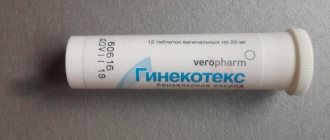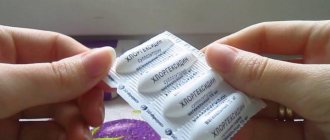Digestive problems often become a serious obstacle to a person’s normal life, especially if it is associated with constipation. In addition to discomfort, this phenomenon can cause intoxication and affect the condition of the skin, hair and nails. A good remedy to ease bowel movements during constipation is Dulcolax. Suppositories, tablets and drops under this name are actively advertised, but are they really that effective? To understand all the pros and cons of a laxative medicine, you should carefully study the instructions for use and reviews about it.
Pharmacodynamics and pharmacokinetics
Dulcolax is a prodrug. Oral administration of bisacodyl leads to its hydrolysis in an alkaline environment with the release of a substance that has irritating effects on the gastrointestinal mucosa , namely in the large intestine it increases the secretion of mucus , and also increases and accelerates its peristalsis .
Laxative effects develop over 6-10 hours when taken while awake and over 8-12 hours when taken before bed.
Dulcolax suppositories in the large intestine directly affect the nerve endings of its mucosa , stimulating excessive mucus , as well as increasing and accelerating its peristalsis .
Dulcolax tablets, due to their coating, are resistant to the effects of gastric juice , and therefore, the release of bisacodyl occurs in the large intestine with the release of an active, non-absorbable metabolite.
Some part of the drug (from 3 to 17%) is excreted by the kidneys. glucuronides are mainly found in blood and urine .
Mechanism of action
How does this medication work? The active substance of all dosage forms, after entering the gastrointestinal tract, reaches the large intestine unchanged. Under the influence of intestinal bacteria, it breaks down into metabolites, which have a laxative effect. Firstly, bisacodyl derivatives irritate intestinal receptors localized in the large intestine, as a result of which mucus production increases significantly. Secondly, these compounds prevent the absorption of fluid from stool by the intestinal villi. And thirdly, under their influence, peristalsis increases.
What does the instructions for use say about the time of onset of the effect after using the drug "Dulcolax"? The suppositories begin to act approximately an hour after their administration. The activity of tablets and drops occurs somewhat later, after about 6 hours. If the drug is taken orally before bedtime, the effect will be noticeable after 8-12 hours.
Since bisacodyl and its metabolites are not absorbed in the intestine, they practically do not enter the systemic circulation, and are also not found in the liver and bile. The medicine is eliminated through the digestive tract.
Indications for use
For tablets
- constipation caused by hypotension of the colon (after childbirth and surgery, in bedridden patients or in old age);
- correction of stool for anal fissures , proctitis , hemorrhoids ;
- preparation ( cleansing ) of the intestines for x-ray and instrumental procedures, as well as preoperative preparation.
For candles
- constipation caused by hypotension of the colon ;
- preparation ( cleansing ) of the intestines for x-ray and instrumental procedures, as well as preoperative preparation.
Contraindications
- acute hemorrhoids ;
- obstructive painful bowel conditions;
- intestinal obstruction;
- pathologists of the abdominal organs of an acute nature, including inflammation of the appendix ;
- spastic constipation;
- hypersensitivity;
- acute inflammatory bowel diseases;
- strangulated hernia;
- severe dehydration ;
- acute proctitis;
- severe pain in the abdominal area, with symptoms of nausea turning into vomiting , due to a possible more severe painful condition;
- bleeding from the gastrointestinal tract;
- age up to 4 years (for tablets) and up to 6 years (for suppositories);
- and/or fructose intolerance (for tablets).
Carefully:
- breastfeeding time and pregnancy ;
- pathologies of the kidneys and/or liver.
Side effects
- allergic manifestations;
- flatulence;
- spasmodic pain in the abdominal area;
- diarrhea , which increases the risk of dehydration and water-electrolyte ( convulsions , muscle weakness , low blood pressure );
- intestinal atony (for suppositories), with long-term use or high doses.
Adverse reactions
Regarding the use of all dosage forms of the laxative "Dulcolax", the instructions for use indicate that there is a risk of side effects. While taking medications, the patient may experience colic or abdominal pain, accompanied by increased gas formation. There is also information about allergic reactions to the components of the drug, expressed in the appearance of a rash on the skin, itching in the rectum (when using rectal suppositories) and the like.
In addition, diarrhea may occur, which, if you continue to take any dosage form of the drug Dulcolax, may be complicated by dehydration, decreased blood pressure, muscle weakness and cramps.
As mentioned above, all adverse reactions can be exacerbated by the simultaneous use of laxatives and dairy products.
Instructions for use of Dulcolax
According to the instructions for Dulcolax tablets, they are taken orally (orally) and can be washed down with water.
Patients over 10 years of age with constipation are usually prescribed 5-10 mg (1-2 tablets) per 24 hours. It is recommended to start taking the drug with a minimum dose, gradually increasing it (if necessary) until you achieve regular bowel movements . The maximum permissible daily dose is 10 mg.
From 4 to 10 years of age, it is recommended to take 5 mg (1 tablet) every 24 hours. This dosage is the maximum permissible daily dose for patients in this age group.
In order for the laxative effect to develop in the morning, you should take the tablets the night before.
It is not recommended to take tablets together with liquids, foods and drugs that reduce gastric acidity (milk, proton pump inhibitors , antacids , etc.) in order to avoid premature disintegration of the enteric membrane.
To prepare the patient for operations, X-ray or instrumental examinations of the intestines and other similar procedures, Dulcolax is prescribed under the supervision of medical personnel.
Usually prescribed 10 mg (2 tablets) at night, 24 hours before and on the eve of the examination or surgery.
For adults, use in combination with suppositories is allowed, in addition to the above evening tablets, administration of 1 suppository in the morning.
Dulcolax suppositories, instructions for use recommend using rectally ( into the rectum ). Suppositories should be inserted deeply, with the pointed end forward. Without a doctor's recommendation, you should not use suppositories for more than 7 days.
Patients over 10 years of age are prescribed 1 suppository once or twice (less often) per day.
At the age of 6 to 10 years, the use of ½ suppository once or twice (less often) per day is indicated.
Dosage forms
The laxative "Dulcolax", reviews of which will be discussed further, is available in several dosage forms:
- Enteric-coated tablets.
- Dragee for oral administration.
- Rectal suppositories.
- Drops for oral administration.
The instructions for use list the compound bisacodyl as the active ingredient in Dulcolax tablets and suppositories. One tablet, enteric-coated or conventionally coated (dragée), contains 5 mg of the active substance. In suppositories the amount of this compound is 5 or 10 mg. The drops contain another active ingredient - sodium picosulfate monohydrate, the content of which in the drug is about 7.5 mg/1 ml (15 drops).
Dulcolax tablets have a round shape without marks, the shell is yellow-orange. They are placed in contoured opaque white cell packaging of 10 pieces each. One package contains 20, 30, 50 or 100 tablets.
The instructions describe Dulcolax suppositories as torpedo-shaped, white or slightly grayish suppositories without a characteristic odor. They are placed in white contour plastic packages of 6 pieces each. One box holds 6, 12 or 18 candles.
The drops are transparent, their color varies from yellow to yellowish-brown. They are packaged in bottles made of transparent plastic or glass, equipped with a dispenser. The volume of drops in one package is 30, 50 or 75 ml.
Overdose
In case of acute overdose of Dulcolax tablets, the following are possible: dehydration , diarrhea , decreased blood pressure , hypokalemia , electrolyte imbalance, convulsions .
In case of chronic overdose, the following were observed: abdominal pain, chronic diarrhea , hypokalemia , urolithiasis , hyperaldosteronism .
It is also possible to develop metabolic alkalosis , renal tubular , and muscle weakness .
In all cases, symptomatic treatment is indicated. In acute cases, induce vomiting and perform gastric lavage . It is also recommended to replenish fluids and adjust the electrolyte balance ; it is possible to prescribe antispasmodics .
Overdose: signs and treatment
With prolonged use or non-compliance with the recommended dosage regimens for the drug "Dulcolax" (reviews will be presented below), an overdose may occur. Symptoms of this phenomenon may include prolonged incessant diarrhea, atony of the large intestine and dehydration. Laboratory tests may reveal hypokalemia and general fluid and electrolyte imbalance. When overdosing on Dulcolax, patients often suffer from severe weakness and dizziness.
Treatment in the above situations should be carried out based on the existing symptoms. As a rule, it is enough for the patient to stop taking the laxative and start drinking plenty of fluids.
Interaction
The combined use of high doses of Dulcolax with glucocorticoids or diuretics increases the risk of electrolyte imbalance ( hypokalemia ).
Hypokalemia increases the effects of cardiac glycosides .
Simultaneous use of Dulcolax tablets with antacid drugs, as well as with alkaline mineral water and milk, can prematurely destroy the tablet shell and, as a result, lead to gastrointestinal irritation .
special instructions
It is not recommended to use Dulcolax for a long time, without determining the causes of constipation .
Long-term use of the drug, especially in high doses, can cause fluid loss , electrolyte imbalance and hypokalemia .
Loss of fluid through the intestines leads to dehydration, with symptoms of thirst and oliguria.
Dehydration negatively affects the body, especially in patients with renal failure and elderly patients, and therefore, if symptoms of dehydration of bisacodyl should be discontinued .
When using Dulcolax, a small amount of blood may be observed in the stool , which, as a rule, is mild and disappears on its own.
Occasionally observed dizziness , as well as fainting , during the use of bisacodyl , are most likely associated with a vasovagal response to abdominal pain or strain during defecation, and are not a consequence of treatment.
Pharmacological action of Dulcolax
The therapeutic effect of Dulcolax is ensured due to the pharmacological properties of its constituent bisacodyl, which is a derivative of diphenylmethane. It acts as a local laxative that provides an antiresorptive effect.
The mechanism of the laxative effect of the drug in tablet form is determined by an increase in the penetration of water into the intestinal cavity and at the same time a decrease in its absorption. At the same time, an important role in the mechanism of action of bisacodyl included in Dulcolax, which is essentially a prodrug, is played by the breakdown of the latter in the alkaline environment of the intestines, which, in turn, leads to the formation of substances that irritate the receptors of the mucous membrane of the intestinal walls, stimulation of the act of defecation, softening intestinal contents, as well as reducing the time of its evacuation.
The use of Dulcolax suppositories helps to increase the secretion of mucus in the large intestine, and also accelerates and increases its peristalsis. The mechanism of action of bisacodyl in the form of suppositories is determined by direct stimulation of nerve endings located in the intestinal mucosa.
Reviews of Dulcolax indicate that it usually takes 6 to 10 hours for the laxative effect to develop after using it in tablet form. If the drug is taken before bedtime - from 8 to 12 hours.
Analogs
Level 4 ATX code matches:
Slabicap
Kafiol
Guttasil
Senadexin
Laxigal
Senna leaves
Herbion Laksana
Castor oil
Bisacodyl
Regulax Picosulfate
Regulax
Weak
Mukofalk
Senade
Guttalax
- Agiolax;
- Glaxenna;
- Antrasennin;
- Guttalax;
- Laxigal;
- Regulax;
- Mukofalk;
- Senade;
- Slabicap;
- Slabilaks;
- Senadexin , etc.
Reviews of Dulcolax
Reviews of Dulcolax range from extremely positive to strongly negative. Some patients are completely satisfied with the laxative effects of the drug, while others, on the contrary, only note increased pain , spasms and other negative phenomena. This may be due to intolerance by some patients to bisacodyl , or improper use of its dosage forms.
It is worth noting that doctors themselves quite often prescribe bisacodyl for constipation and other similar conditions and are often completely satisfied with the results obtained.
Reviews
One of the most reliable sources about the use and frequency of side effects when taking the laxative “Dulcolax” is reviews. Tablets, suppositories and drops, judging by the commercials, effectively and safely relieve constipation. How are things really going? According to surveys, all dosage forms of the drug really help get rid of difficulties with bowel movements. A large number of consumers indicated the convenience of using tablets or drops in the evening. In this case, stool occurs in the morning.
About half of the patients with chronic constipation noticed that when taking two tablets at a time (this dosage is provided for in the instructions for use), severe diarrhea may develop. That is why experts recommend starting treatment for constipation with one tablet per day. If this dose does not bring the expected result, after a day it can be increased to two tablets. Experts advise postponing important trips and meetings before taking the drug, since the body’s reaction is individual in each case.
To eliminate constipation in children, doctors recommend using suppositories, since they act more gently and cannot affect the condition of the stomach and duodenum. In addition, reviews say that Dulcolax suppositories practically do not cause allergic reactions. Consumer reviews of candles are also called the most suitable remedy for emergency relief of constipation. They confirm that the effect occurs within one hour. At the same time, they notice that it is better to use them during the day rather than in the evening. Otherwise, you won't be able to get enough sleep.
The drug also receives negative reviews. For example, many people thought his action was too harsh. Thus, about fifteen percent of the total number of respondents indicated very severe abdominal pain after taking Dulcolax tablets. About half of them named increased gas production as the main cause of pain.
Many consumers consider the price of the laxative “Dulcolax” to be affordable. For example, a package of twenty tablets costs about 150-180 rubles. This amount of medicine may last for a long time, especially considering that taking it for more than three days in a row is not recommended.
Dulcolax price, where to buy
On average, the price of Dulcolax in tablets is 250 rubles; in candles – 220 rubles.
- Online pharmacies in RussiaRussia
- Online pharmacies in KazakhstanKazakhstan
ZdravCity
- Dulcolax tablets p.p.o.
enteric solution 5mg 30 pcs.Boehringer Ingelh.France SAS/Delpharm Reims RUB 202 order
Pharmacy Dialogue
- Dulcolax tablets 5 mg No. 30 Boehringer Ingelheim
RUB 234 order
show more











